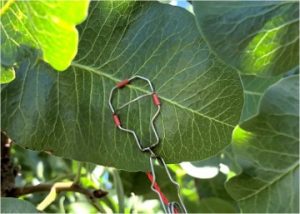more information....
 option 1: TEROS 21 soil water sensor
option 1: TEROS 21 soil water sensor
The best sensor you will ever use is the TEROS 21 Soil Water Potential Sensor. The TEROS 21, formally known as the MPS-6 sensor, gives you a number whereby you can clearly make irrigation decisions.
The sensor is pre-calibrated and there is no ongoing maintenance. It is a digital sensor so it can connect to wireless technology.
The TEROS 21 is a soil, point sensor so it only measures a small volume of the environment experienced by the vines or trees.
But, as a low cost, first up option, it is definitely the best:
https://edaphic.com.au/products/soils/soil-water-potential-sensors-meters/
 option 2: evapotranspiration (ETo)
option 2: evapotranspiration (ETo)
Evapotranspiration (ETo), or crop evapotranspiration (ETc) is a gold standard measurement for an irrigation manager.
For a general, broad overview of the vineyard environment, and the calculation of irrigation decisions via evapotranspiration, an excellent option is the ATMOS-41 All-In-One Weather Station.
The ATMOS-41 is about the size of a football and it has all the sensors, in a single unit, to measure temperature, rainfall, wind, humidity, and more, for growers.
The ATMOS-41 is another cost-effective option for a broad overview of the farm, vineyard or orchard:
https://edaphic.com.au/meteorology/
 option 3: crop water use (sap flow sensor)
option 3: crop water use (sap flow sensor)
The Implexx Sap Flow Sensor directly measures crop water use, or crop evapotranspiration, from the plant.
The Implexx Sap Flow Sensor is easy to use, install and maintain and it is calibrated to measure accurately in any woody crop.
Sap flow data can be used to monitor water stress, response to extreme events such as heatwaves, as well as irrigation management by calculating dosage and irrigation timing.
In combination with evapotranspiration data from the ATMOS-41 weather station, the Implexx Sap Flow Sensor provides a comprehensive understanding of crop water use. See below for more details on sap flow and irrigation management.
https://edaphic.com.au/products/sap-flow-sensors/
 option 4: plant water potential (pressure chambers)
option 4: plant water potential (pressure chambers)
For decades, pressure chambers have been the gold standard measurement for irrigation management and scientific research.
Pressure chambers measure the water potential of plants to determine their hydration level. The results can be used to directly determine the water stress level of the plant and for irrigation management.
Pressure chambers are popular in vineyards where they are routinely used for precision irrigation management, improving BRIX and colouring, as well as other irrigation strategies.
https://edaphic.com.au/plant-and-leaf-water-potential/
 option 5: trunk and fruit dendrometers
option 5: trunk and fruit dendrometers
A dendrometer measures the growth and water use of plants. It is an excellent option because they are easy to install and maintain.
They also measure water use and growth of the plant so it is possible to combine managements decisions on both irrigation and fertilisation.
Our dendrometers are digital and can connect to wireless networks. Two types of dendrometers are available: trunk dendrometers for irrigation monitoring; and fruit dendrometers that can be used for irrigation monitoring or for fruit sizing.
https://edaphic.com.au/products/dendrometers/
 option 6: leaf temperature sensors
option 6: leaf temperature sensors
For smaller or herbaceous crops, such as wheat, rice, tomatoes, cotton, and more, the most cost-effective and easiest option is a leaf or canopy temperature sensor.
Leaf and canopy temperature sensors must be used in combination with measurements of ambient air temperature. When the leaf or canopy temperature approaches ambient air temperature, then the plant is stressed.
There has been a large amount of research relating canopy temperature to irrigation scheduling in plants.
The sensors are easy to install and maintain. They are digital and can connect to wireless networks:
Leaf temperature sensor: https://edaphic.com.au/temperature/leaf-temperature-sensor/






